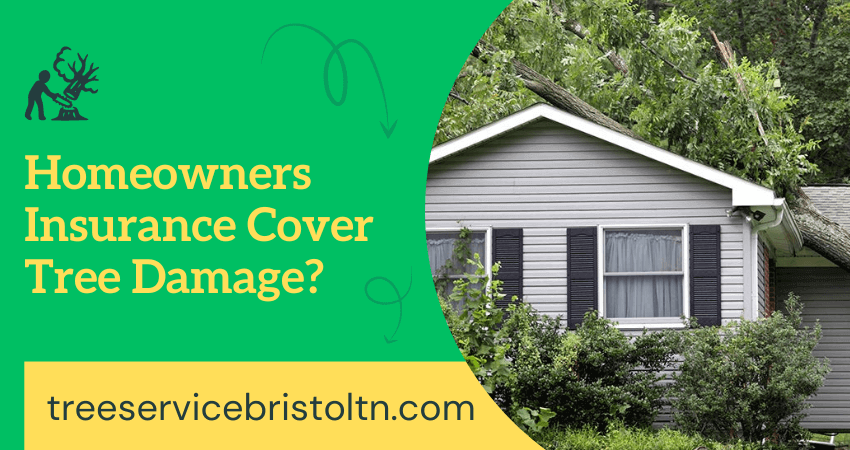Trees can be a blessing, providing shade and adding beauty to your home’s landscape. But when an unexpected storm hits and causes branches or even entire trees to come crashing down onto your roof or into your yard, you start to question whether homeowners insurance will cover the damage.
Understanding what is and isn’t covered by homeowners insurance, with respect to tree-related damage will help ensure that you’re protected against financial losses and emergency expenses resulting from catastrophes like windstorms, tornadoes, ice storms, falling limbs and more.
In this article, we’ll explore the coverage of homeowners insurance for tree damage, what is covered, and what is not, as well as tips to help you make an informed decision.
If a tree falls on my house, will my homeowner’s insurance policy cover the damages?
Most likely, yes! Homeowner’s insurance policies typically cover damage to your property caused by falling trees. Depending on the specifics of your policy and the circumstances of the tree fall, you may be able to get compensation for repair costs or replacement value from your insurer. It’s important to review your policy thoroughly in order to understand exactly what coverage you have.
If you do decide to file a claim, there are several steps you’ll need to take. First, make sure the falling tree has caused damages covered by your policy. Then notify the insurance company that you wish to file a claim and provide documentation of the damages.
You may also need to take pictures or videos of the incident and submit them to your insurer. In some cases, you may also need to have an adjuster come out and assess the damage before the claim is processed.
Once the insurance company has reviewed all of the relevant information, they will make a decision about whether or not to cover your claim. If your claim is approved, you’ll receive compensation for the costs of repair or replacement. Be sure to keep all receipts and records in case you need to provide proof of any repairs or replacements.
Tree damage causes typically covered by home insurance
- Wind Damage: Some policies cover damage to trees caused by wind, hail, and ice storms if the insured has added a specific rider for it.
- Fire Damage: If a fire spreads from your home or other structure on your property to nearby trees, most policies will cover it.
- Lightning Damage: Homeowners’ insurance usually covers lightning damage to trees as long as the tree was not already impaired or diseased.
- Vehicle Damage: If a car hits a tree on your property, home insurance can cover it.
- Vandalism and Theft Damage: Most policies provide coverage for any deliberate act of destruction and theft of trees on the insured property.
- Damage Caused by Animals: Damage to trees caused by wild animals is often covered under home insurance policies, provided there is no evidence that suggests intentional infliction of injury or damage.
- Disease and Insect Damage: Disease and insect infestations can cause severe damage to trees and home insurance may cover this, depending on the type of coverage you have.
- Weight Damage: If a tree collapses due to the weight of snow or ice, your home insurance policy will generally provide coverage for it.
- Damage Caused by Utility Companies: In some cases, if utility companies, such as electric or phone companies, damage your trees when performing their work, your home insurance policy may cover it.
Tree damage causes typically not covered by home insurance:
- Fire
- Damage caused by wind, hail, or ice storms
- Damage caused to tree roots from construction or excavation activities
- Damage caused by disease, animals, insects, weeds, or other plant diseases
- Vandalism and malicious mischief of trees
- Fungal and bacterial infections
- Damage from falling objects
- Damage caused by landscaping activities
Do homeowners insurance cover tree removal?
In most cases, homeowners insurance does not cover the cost of removing a tree that has been damaged by natural causes such as wind or lightning. However, if a homeowner has purchased additional coverage for the removal of trees and shrubs, they may be able to recover some costs associated with the removal. It’s important to read your policy carefully to determine what is and isn’t covered.
In some cases, homeowners can also be reimbursed for the cost of professional removal if the tree was damaged due to a covered peril (such as vandalism or malicious mischief). Again, it’s essential to read your policy to understand what is and isn’t included in your coverage.
In order to save time, money, and energy while dealing with tree damage, it’s important that homeowners understand their insurance policy. Homeowners should also take preventative measures to protect the trees on their property by regularly pruning them and removing dead branches.
By taking proper care of your trees, you can minimize the chances of them being damaged by natural causes.
Finally, it’s important to contact your insurance provider and ask any questions you may have about tree damage coverage before filing a claim. Knowing what is and isn’t covered in your policy can ensure you receive the best possible outcome in the event of tree damage.
What to do when someone else’s tree damages your property?
If a tree from someone else’s property damages your property, then you may be able to file a claim for compensation. Generally, it is best to notify the owner of the tree or their insurance company and explain the situation. Depending on the circumstances, they may be liable for any damage caused by their tree.
It is important to take pictures and keep records of any damage that was caused by the tree in order to make a strong case for your claim. You may also need to consult an attorney or contact a local tree services company to help assess the situation.
If there is no resolution through traditional means, then you may need to file a lawsuit against the tree owner. This process can be costly and time-consuming, so it is important to understand all the relevant laws before taking this step.
In some cases, you may even need to contact your local municipality for assistance in resolving the issue. The city or town may have ordinances that require a tree owner to take responsibility for any damage caused by their tree.
Regardless of the situation, it is important to contact the right people and take all the necessary steps to ensure that you get the compensation you deserve for any damage caused by someone else’s tree.
How to prevent tree damage?
Tree damage caused by storms, heavy winds, and other environmental factors can be a major problem. To help prevent this damage, there are several steps you can take:
- Inspect trees regularly for any signs of disease or insect infestations. If any problems are found, contact a certified arborist to assess the risk and offer advice on how to address it.
- Trim any branches that are broken or dead, as well as those that are growing too close to power lines or other structures.
- Plant trees in areas with good drainage and soil that give them the best chance of survival.
- Prune trees regularly to maintain their shape and form.
- Anchor trees with guy wires or other supports to help them withstand high winds.
- Add mulch and fertilizer to the soil around your trees to ensure they have access to the essential nutrients they need.
- Water your trees regularly, especially during hot, dry periods.
- Use tree-friendly products like wood chips or compost to reduce the risk of plant damage.
By following these simple steps, you can help ensure that your trees remain healthy and strong despite any environmental factors they may face.
Conclusion
In most cases, yes, homeowners insurance will cover tree damage. However, there are some instances in which your policy may not provide coverage. It’s important to read your policy carefully and contact your insurer if you have any questions.
You can also consult with a local tree service company to get an estimate of the damage and discuss your options for repair or replacement.



